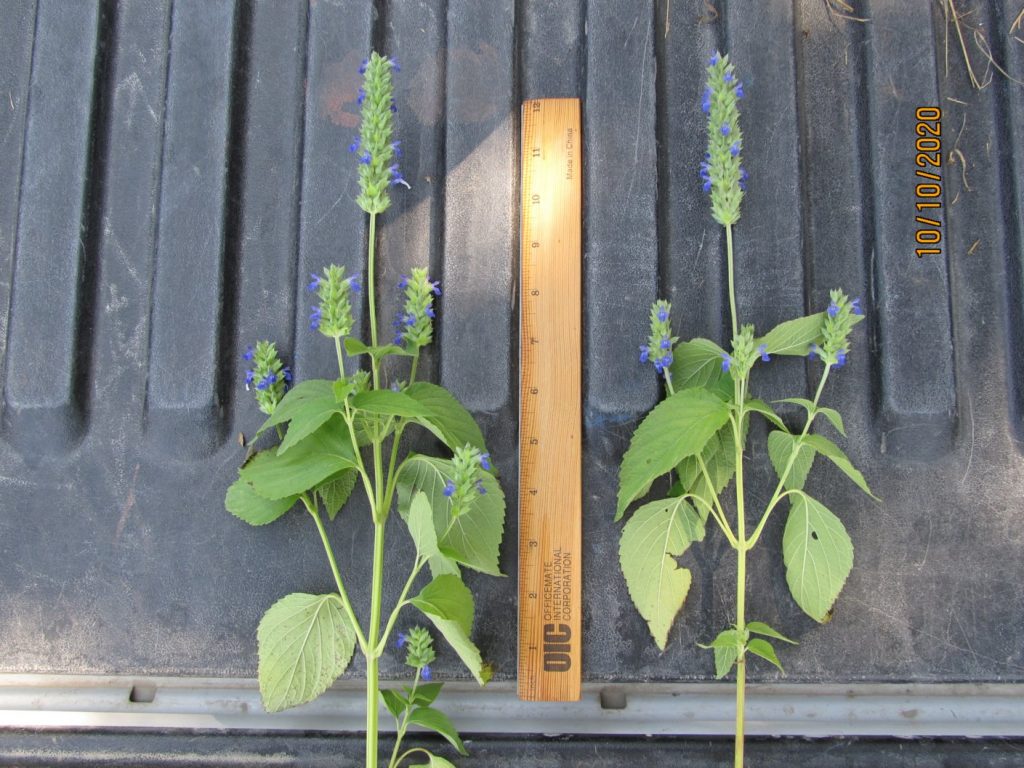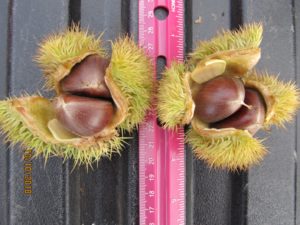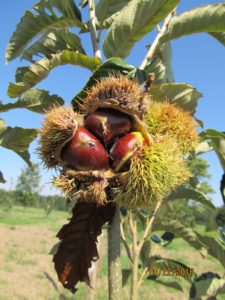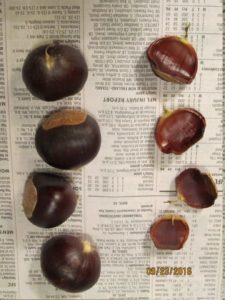Here are some pictures taken in October and November.



Here are some pictures taken in October and November.



The Chinese chestnut trees growing on my property seem to know how to maximize their energy expenditure.
Normally there are three nuts in each spiney burr. The burr on the left in the following picture has opened but still retains the three fully developed nuts peeping out. The burr on the right has one developed nut and two blanks.
In the following picture each burr has one blank and two developed nuts.

It seems that the tree knows enough to parcel out its energy into developing one or two full nuts and leaving the others blank rather than spreading energy over all the nuts.
And here is one where none of the three nuts developed.
And the following picture show an array of blanks.
The following shows an array of developed nuts.
All the normal maintenance tasks listed in the 2015 year in review posting continued through this year. Again this year I sprouted some some pecan seed nuts and Chinese chestnut seed nuts and grew them in pots. In November I transferred the potted trees to a straw bale fort and covered them with mulch to protect them during the cold winter months.
During October and November I planted 54 more trees from pots into the fields as follows:
– 12 grafted kanza pecan
– 6 grafted major pecan
– 25 seedling pecan
– 6 seedling shellbark hictory
– 2 grafted homewood Chinese chestnut
– 1 grafted gideon Chinese chestnut
– 1 grafted sauber black walnut
– 1 grafted sparrow black walnut
I am interested in growing cover crops to protect the soil. So, in August, September, and October I sowed mixes of the following seeds in various fields to study how they grow in different soils with different sowing methods and at different sowing dates.
– daikon radish
– cereal rye
– radish
– sudangrass
– winter peas
– hairy vetch
– triticale
Over the next few years I need to decide what vegetation under the trees will facilitate harvesting. Also, I hope to get rid of the fescue grass that robs the soil of moisture.
These last four years have gone by quite fast. But, I am still in the beginning stages of establishing a nut tree farm. There remains lots of work and lots of learning for future years.
Harvest of my first ever crop of Chinese chestnuts started about the middle of September and went through the first week of October. The trees were transplanted into the field in October, 2012, from pots. The 19 trees had about 30 burrs total which produced over 60 filled nuts and a number of blank empty nut shells.
Not all trees planted that year had burrs. The count of burrs by variety of tree is: three of three homestead trees had burrs, one of three peach trees, two of three eaton trees, one of three quing trees, and one of six seedling trees. And although the burrs have three nuts each, usually one nut is a flat shell with no nutmeat inside it. The first trees to drop nuts from the burrs were eaton. The homestead and seedling burrs were last to drop their nuts.
In the following picture you can see one burr near the top of the tree that has started to open up.
The following picture shows a burr still on the tree that has started to split apart but with the nuts still inside it.

Voilà, some nuts have dropped out of the burrs onto the ground.
And this picture shows some fully developed nuts on the left and empty blanks to the right.

After the nuts drop out the burrs will eventually fall to the ground and turn brown. Note – those needle stickers are very sharp.
And here is a close up of another burr where the middle and right side nuts filled out but a the left side is an empty blank.
========================================================
One way to cook the nuts is to bake them in a 350 degree oven for about 20 minutes. BUT, first the brown shell of each nut must be scored with a knife. The nuts will explode like popcorn if not scored. Here are some nuts that have been scored in preparation for baking.
And in the next picture you can see the nuts after baking in the oven. The thin shells have opened up along the score lines and reveal the yellow tinged nutmeat. Each nut has a thin gauze like substance between the shell and the nutmeat.
The next picture was taken after a two-legged mouse sampled the product.